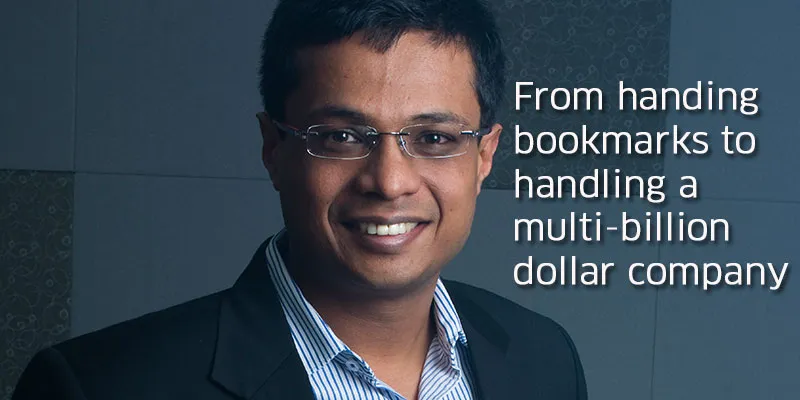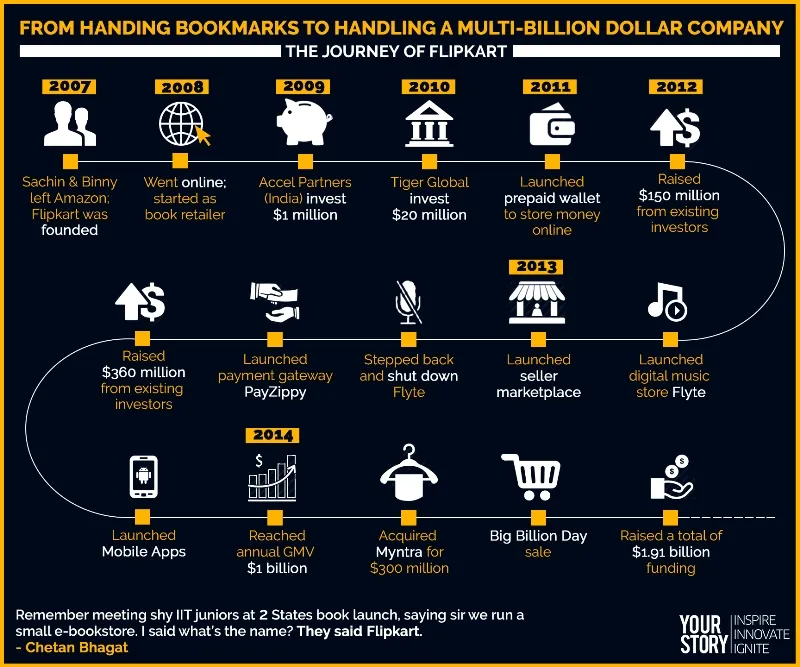7-yr-old Flipkart's evolution through the eyes of Sachin Bansal
Alexa rank 7, fresh capital of $1 billion, 14000 employees and day by day inching towards becoming India’s first $100 billion internet company. Today, as Sachin Bansal turns 33, he surely does have multiple reasons to celebrate his success but there’s much more to the story beyond these numbers.
Sachin admitted in an interview that starting Flipkart is the most ridiculous thing he has ever done and everyone around him thought that he was out of his mind. YourStory explores the evolution of Flipkart and Sachin Bansal over the last seven years, from the eyes of the founder himself.

The genesis
In an interview with YourStory in 2010, Sachin had said, “The idea itself is not new. The genesis of the thought to set up Flipkart came from the bad quality service provided by competitors. Our business opportunity was to do better than our competition in terms of service. Hence, our main mission was to focus on customer service. As a startup company with ambitions in the ecommerce domain, we had to choose a category that could facilitate getting started quickly. The low transaction size helped induce customer trials. With our strong technology background, we could keep the initial costs low.”
Getting it right offline
Seven years ago when Flipkart was started as an online platform for selling books, Sachin remembers going across the roads of Bangalore to procure the orders from small distributors. Recalling one of the marketing strategies, he says,
We used to stand outside Gangaram Book Stores on Church Street and hand over Flipkart bookmarks to the people coming out of the shop. In order to make sure that our targeting was right, we would give bookmarks to only those who were coming out with books in hands; the people who have made purchases.
Over the years, marketing has evolved and Flipkart has taken a more sophisticated approach.
Also read: Flipkart ties-up with Mumbai Dabbawalas, dabbles with an on-demand logistics service too
Power of Ecommerce
Sachin believes that ecommerce has changed the way we live. He says, “Recently when Motorola tied up with Flipkart for the exclusive launch of Moto-G in India, they were launching the product in India before the rest of the world. I would count that as an achievement for ecommerce. This would not have happened if there was not an unparalleled access to customers around India. It took 5 seconds to get over with the whole stock of Xioami Mi3 when the booking was opened for the second time for 20000 phones. This is nothing but the power of ecommerce.”
He proudly shares that Flipkart’s delivery boys are almost like Santa Claus for many customers.
Challenges – now and then
Do you know VVK Chandra? He was the person who placed the first order on Flipkart. More interesting than this fact is the interview of Flipkart’s founders, which he published in 2008 on his blog. Sachin spoke about the challenges in the initial days, “One major challenge was to get tie-ups with the major book vendors as we didn’t have an offline book store. The second major challenge was to get the approval for the credit card payment gateway.”
Today, Flipkart has almost each and every book vendor/publisher on board and even its own payment gateway, Payzippy. The newer challenges are with respect to maintaining a great customer experience with the massive increase in demand. Supply chain efficiency, talent management and technology innovation surface are the other major challenges.
Drawing parallels
Sachin Bansal has always seen Flipkart as an Indian Alibaba rather than an Indian Amazon. Drawing some parallels with China’s Alibaba, he says, “Yahoo had invested the same amount in Alibaba in 2005. It was the inflexion point in China then, exactly where India is today.”
He speaks about the possibility of an IPO, "The world is different as compared to 10 years ago. Private investors have more appetite and patience. Also, we’re figuring out stuff about our own business. When we feel that the market is ready and our business model is not evolving (and stabilized), we will be ready for an IPO."
If nothing, two things can be immediately understood from this comparison:
- Sachin is eyeing for a similar valuation for Flipkart in the coming years.
- IPO is uncertain as of now. It might well take more time as the founders seems to be in no hurry (with enough support from current investors).
Opportunity over the years
Sachin had stated before that 'No' is a very difficult word and more so in our culture where people quickly tend to take offense. But a No which makes your business and customer say YES is worth the while.
Sachin has seen a lot of opportunities in Flipkart’s seven years of existence. He sees challenges as opportunities and believes that if we can solve challenges then it automatically becomes opportunity for everyone. “Youngsters want to live their lives on the internet. The future is bright and we are placed right. India can produce a $ 100 billion company in the next five years and we want to be that company. It is going to be one of the most difficult tasks ever done by an Indian company but it’s possible.”
Also read: Keeping the innovation engines at full throttle, the Flipkart way
Long term game
Flipkart plans to invest most of the raised funds in technology, supply chain and in building a better talent pool. Sachin believes that this helps him think long term. He says, “If you look at big internet companies, they have defined how commerce ecosystem will shape in the future. We are also in the same process. For us the challenges are to take logistics to small towns and villages. Making payments easy for the consumer will also play an important role.”
Flipkart’s more than 50% revenue comes from mobile, and mobile has been at the core of Sachin’s plan right from the beginning. He says, “Mobile gives you 10 times data as compared to desktop. People browse more often in mobile, there are sensors like camera, GPS; which are tools giving more information about the user. This helps in providing them with better/more localized experiences.”
Blast from the past
Here’s an advice from Sachin and Binny Bansal to which both of them resonated in 2010,
Don’t start out alone, it helps to have a co-founder when things are not going your way. You have not done your job well until you find a stranger who is willing to open his/her wallet to give you money for the services/products that you a offering.
What makes us proud?
Jeff Bezos’ wealth is $32.2 billion while 30-year-old Zuckerberg’s net worth just crossed $33 billion mark after Facebook’s 2014 Q2 earnings. But the news of Flipkart being valued as a multi-billion dollar entity is way more heartening than the former two. I believe the ‘Indian-ness’ makes the whole difference.
Update: Here's an Infographic by YourStory on the 7-year-old Flipkart's journey:








